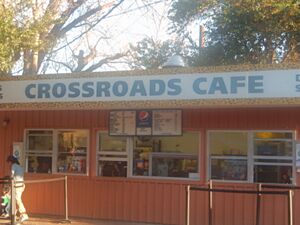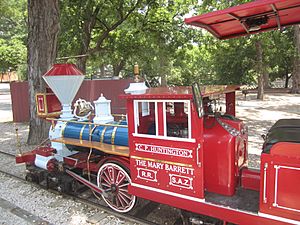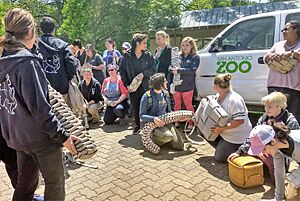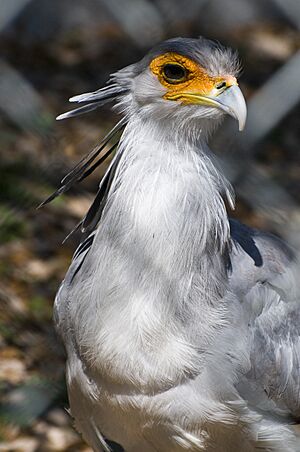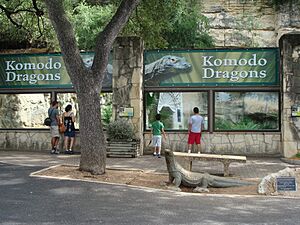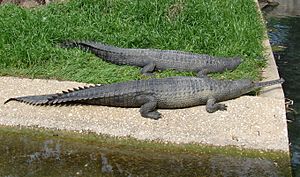San Antonio Zoo facts for kids

San Antonio Zoo logo
|
|
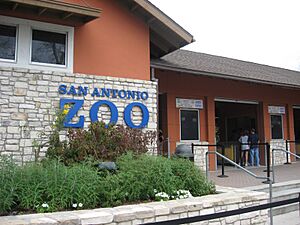
Zoo entrance
|
|
| Date opened | May 3, 1914 |
|---|---|
| Location | 3903 N. St. Mary's Street San Antonio, Texas, United States |
| Land area | 57 acres (23 ha) |
| Coordinates | 29°27′53″N 98°28′19″W / 29.4648°N 98.4719°W |
| No. of animals | 3,500+ |
| No. of species | 750 |
| Annual visitors | 1.1 million+ |
| Memberships | AZA, ZAA |
The San Antonio Zoo is a fun place to visit in Brackenridge Park in San Antonio, Texas, USA. It covers about 57 acres and is home to more than 750 different kinds of animals. Some of these animals are very rare or no longer live in the wild. Over 1 million people visit the zoo every year!
The zoo also has the Richard Friedrich Aquarium, which opened in 1948. For many years, it was the only aquarium in San Antonio. You can also enjoy other attractions like the San Antonio Zoo Train, which started running in 1956.
Contents
Exploring the San Antonio Zoo
The San Antonio Zoo is located in the Midtown area of San Antonio. It is officially recognized by the Association of Zoos and Aquariums (AZA) and the Zoological Association of America (ZAA). This means it meets high standards for animal care and education.
Cool Exhibits and Buildings
The Monkey House and Commissary
|
Monkey House/Commissary (San Antonio Zoo)
|
|
| Built | 1937 |
|---|---|
| Architect | Adams & Adams |
| Architectural style | Spanish Revival |
| MPS | Historic Buildings and Structures of the San Antonio Zoo |
| NRHP reference No. | 100010141 |
| Added to NRHP | April 4, 2024 |
The Monkey House and Commissary building at the San Antonio Zoo was built a long time ago, between 1935 and 1937. It was designed in a cool Spanish Revival style. Over the years, this building has been used for many things. It was a place where animal food was stored, a vet office, and even where monkeys lived.
In 2023, the building was updated. Now, it has places to buy snacks and drinks, and restrooms for visitors. It was added to the National Register of Historic Places in 2024 because of its special design.
Riding the San Antonio Zoo Train
The San Antonio Zoo Train used to be called the Brackenridge Eagle. It is a small train that takes visitors around Brackenridge Park. You can ride it from the zoo to other interesting spots in the park. The train first opened in 1956. It was very popular, carrying 1 million passengers in its first two years!
A Look Back at the Zoo's History
How the Zoo Started
The San Antonio Zoo began in 1914. A kind citizen named George Washington Brackenridge gave some land to the city. He also placed several animals there, including bison, deer, monkeys, African lions, and bears. This land later became Brackenridge Park and a golf course.
In November 1929, the San Antonio Zoo opened some of the first cageless exhibits in the United States. These exhibits gave visitors a much better view of the animals. The Richard Friedrich Aquarium opened in 1948. The Hixon Bird House, a special home for birds, opened in 1966.
The San Antonio Zoo was the first place to have a group of addra gazelles in captivity in 1969. They still help with breeding programs for this critically endangered animal.
The Great (Little) Train Robbery
On July 18, 1970, something unusual happened. Two people stopped the Brackenridge Eagle train and took money and other items from the passengers. Some people thought it was a joke at first! The robbers got away with about $500 and other valuables.
Ten days later, two soldiers were caught for the crime. They were later found guilty. This event was called "the Great (Little) Train Robbery." It was the last train robbery to happen in Texas.
The Zoo in the 21st Century
In 2008, the zoo opened the first part of its "Africa Live!" exhibit. This new area included a special home for hippos with an underwater viewing area. It also featured new Nile crocodiles and many other smaller animals. The second part of "Africa Live!" opened in 2010. It has animals like Angolan colobus monkeys, okapi, and African hunting dogs. It also has many kinds of birds in one of the world's largest aviaries.
In 2013, a very rare two-headed Texas river cooter turtle hatched at the zoo. It was named Thelma and Louise. Sadly, Thelma and Louise passed away in 2014.
In April 2022, an African lion named Josh moved to the Birmingham Zoo. This move was part of a special plan to help different animal species.
The zoo started building a new gorilla habitat called Congo Falls in 2023. The zoo had not had gorillas since 1990. This new habitat is very large, covering about 2 acres. It is expected to open in late 2025.
In October 2024, the San Antonio Zoo opened its biggest habitat ever, the Naylor Savanna. This expanded area gives African animals much more space. It also includes a new barn for giraffes. The Spekboom Lodge, located in the middle of the giraffe habitat, opened in November 2024. Guests can even rent it to spend a night at the zoo!
Helping Animals: Conservation Efforts
The Center for Conservation and Research at the San Antonio Zoo works hard to protect endangered species. They help breed animals like black rhinos, leopards, golden lion tamarins, and dama gazelles. They also work with Attwater's prairie chickens, black mangabeys, African lions, black-footed ferrets, Komodo dragons, Andean condors, and Caribbean flamingos.
The zoo is also involved in the Texas horned lizard Reintroduction Project. They breed these lizards and then release them back into their natural homes. This project works with other groups like the Texas Parks and Wildlife Department. As of 2024, the center had released 258 horned lizards into the wild.
Important Safety Changes
In 1992, a zookeeper was seriously injured by an Asian elephant. This sad event led to an investigation. The zoo decided not to have elephant rides anymore to ensure safety. This was the first time such a serious incident had happened at the zoo.
Amazing Animals at the Zoo
The San Antonio Zoo is home to over 3,500 animals from 750 different species!
Mammals
- Addax
- Addra gazelle
- African lion
- African pygmy goat
- African wild dog
- American black bear
- Angola colobus
- Bactrian Camel
- Bat-eared fox
- Black howler monkey
- Black-and-white ruffed lemur
- Black-footed cat
- Black-tailed prairie dog
- Blue duiker
- Bush dog
- Capybara
- Colombian white-faced capuchin
- Common squirrel monkey
- Common warthog
- Crested porcupine
- Fishing cat
- Fossa
- Francois' langur
- Geoffroy's marmoset
- Giant anteater
- Giraffe
- Golden lion tamarin
- Golden-headed lion tamarin
- Hippopotamus
- Impala
- Indian boar
- Jaguar
- Kinkajou
- Kirk's dik-dik
- Large flying fox
- Linnaeus's two-toed sloth
- Malayan tapir
- Matschie's tree-kangaroo
- Meerkat
- Naked mole-rat
- Nine-banded armadillo
- North American porcupine
- Northern tree shrew
- Ocelot
- Okapi
- Oriental small-clawed otter
- Philippine porcupine
- Plains zebra
- Prevost's squirrel
- Red kangaroo
- Red river hog
- Red ruffed lemur
- Ringtail
- Rock hyrax
- Seba's short-tailed bat
- Sitatunga
- Southern tamandua
- Southern white rhinoceros
- Spectacled bear
- Spotted hyena
- Striped skunk
- Sumatran tiger
- Virginia opossum
- Vietnamese pot-bellied pig
- Western lowland gorilla (coming soon)
- Western grey kangaroo
- White-cheeked gibbon
- Waterbuck
- White-faced saki
- Wolf's guenon
- Yellow-backed duiker
- Yellow-footed rock-wallaby
Birds
- Abdim's stork
- American flamingo
- American white pelican
- Andean tinamou
- Australian wood duck
- Bali myna
- Bar-headed goose
- Black-and-white mannikin
- Black swan
- Black-necked aracari
- Black-necked swan
- Blue-billed teal
- Blue-bellied roller
- Blue-grey tanager
- Boat-billed heron
- Bruce's green pigeon
- Buff-crested bustard
- Chilean flamingo
- Chiloe wigeon
- Common goldeneye
- Congo peafowl
- Crested pigeon
- Crested screamer
- Crested wood partridge
- Crowned hornbill
- Curl-crested aracari
- Demoiselle crane
- Diamond dove
- Double-wattled cassowary
- Eastern screech owl
- Emerald starling
- Emu
- Fulvous whistling duck
- Germain's peacock-pheasant
- Golden-breasted starling
- Great blue turaco
- Greater flamingo
- Greater vasa parrot
- Green aracari
- Green oropendola
- Green-winged macaw
- Green-winged dove
- Grey-winged trumpeter
- Grey crowned crane
- Guam kingfisher
- Guianan toucanet
- Guira cuckoo
- Hadada ibis
- Hammerkop
- Hooded crane
- Hooded merganser
- Inca tern
- Lady Ross's turaco
- Laughing gull
- Laysan teal
- Madagascar teal
- Magpie goose
- Magpie shrike
- Malayan peacock pheasant
- Marabou stork
- Marbled teal
- Masked lapwing
- Metallic starling
- Mindanao bleeding-heart
- Military macaw
- Namaqua dove
- Nicobar pigeon
- Northern pintail
- Ostrich
- Palm cockatoo
- Peruvian thick-knee
- Pied crow
- Pied imperial pigeon
- Purplish jay
- Radjah shelduck
- Raggiana bird-of-paradise
- Rainbow lorikeet
- Red-and-yellow barbet
- Red-capped cardinal
- Red-crested finch
- Redhead duck
- Red-legged honeycreeper
- Red-legged seriema
- Ringed teal
- Rose-ringed parakeet
- Ruddy duck
- Sandhill crane
- Scarlet ibis
- Secretarybird
- Snowy-crowned robin-chat
- Speckled mousebird
- Speckled pigeon
- Straw-necked ibis
- Sulawesi ground dove
- Sunbittern
- Sun conure
- Superb starling
- Swan goose
- Taveta golden weaver
- Tawny frogmouth
- Victoria crowned pigeon
- Violet-backed starling
- Wattled crane
- West African crowned crane
- Western crowned pigeon
- White stork
- White-headed buffalo weaver
- Whooping crane
- Wreathed hornbill
- Yellow-breasted ground dove
- Zebra dove
Reptiles
- African mud turtle
- African rock python
- Aldabra giant tortoise
- Amazon tree boa
- American alligator
- Armstrong’s dusky rattlesnake
- Aruba island rattlesnake
- Ball python
- Banded alligator lizard
- Banded rock rattlesnake
- Black milk snake
- Black wood turtle
- Bull snake
- Caatinga lancehead
- Cagle's map turtle
- California kingsnake
- Chinese crocodile lizard
- Coahuilan box turtle
- Corn snake
- Cross-banded rattlesnake
- Cuban false chameleon
- Cuvier's dwarf caiman
- Dunn's hognose viper
- Durango mountain kingsnake
- Dwarf crocodile
- East African green mamba
- Eastern box turtle
- Emerald alligator lizard
- Eyelash palm-pitviper
- Fly River turtle
- Gharial
- Green tree python
- Grey-banded kingsnake
- Guatemalan palm viper
- Hamilton’s pond turtle
- Humantlan rattlesnake
- Indian flapshell turtle
- Jamaican boa
- King cobra
- Komodo dragon
- Mang Mountain viper
- Mexican alligator lizard
- Mexican beaded lizard
- Mexican lance-headed rattlesnake
- Mexican milksnake
- Mexican mud turtle
- Mexican pygmy rattlesnake
- New Mexico ridge-nosed rattlesnake
- Nile crocodile
- Okinawa habu
- Red spitting cobra
- Red-eared slider
- Reticulated python
- Rhinoceros ratsnake
- Rhinoceros viper
- Rowley's palm-pitviper
- San Luis Potosi kingsnake
- Sheltopusik
- Spider tortoise
- Southern lined pine snake
- Southern alligator lizard
- Speckled palm pitviper
- Spiny-tailed monitor
- Standing's day gecko
- Tamaulipan flat rock lizard
- Tamaulipan rock rattlesnake
- Taylor’s cantil
- Texas river cooter
- Tomistoma
- Trans-Pecos ratsnake
- Veiled chameleon
- West African green mamba
- Western cottonmouth
- Western diamondback rattlesnake
- Western hognose snake
- Western painted turtle
- Yellow sided twist-necked turtle
- Yellow-spotted Amazon river turtle
Amphibians
The original text did not list specific amphibians, but the zoo is home to many!
See also
 In Spanish: Zoológico de San Antonio para niños
In Spanish: Zoológico de San Antonio para niños


